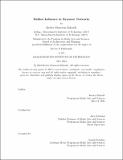Hidden Influence in Dynamic Networks
Author(s)
Erhardt, Keeley Donovan
DownloadThesis PDF (9.646Mb)
Advisor
Pentland, Alex
Terms of use
Metadata
Show full item recordAbstract
Our world is structured by networks that connect objects, ideas, and people. These networks consist of nodes (entities) and edges (connections) that dynamically evolve, reflecting changes in relationships, the emergence of new entities, and the dissolution of old links. Unlike static networks, which offer a snapshot of connections at a specific time, dynamic networks allow for modeling processes and system-level changes over time. These changes shed light on the evolution of social interactions, digital communications, financial transactions, and other networked data. Leveraging mathematical and statistical models, including neural network techniques, this research delves into the hidden influence that weaves through seemingly unrelated, yet intrinsically connected, entities in online social and financial networks. I begin with a foundational overview of graph learning techniques and the specific models utilized in my work. The body of this dissertation is divided into three core sections. The first examines the orchestration of influence campaigns by state-backed entities on social media, utilizing the influence model to unravel the complex interactions among networked Markov chains based on temporal activity patterns. Next, I quantitatively analyze the shifting geopolitical relationships and digital diplomacy efforts between two nation-states, employing a node representation learning strategy. Lastly, I apply a geometric deep learning framework to uncover connections between cryptocurrency wallets, analyzing transaction patterns and temporal dynamics to identify underlying networks. By introducing innovative approaches that leverage probabilistic and deep learning techniques to analyze dynamic networks, this dissertation contributes valuable insights and methodologies with significant implications for diverse domains such as cybersecurity, financial technology, and communications infrastructure.
Date issued
2024-05Department
Program in Media Arts and Sciences (Massachusetts Institute of Technology)Publisher
Massachusetts Institute of Technology